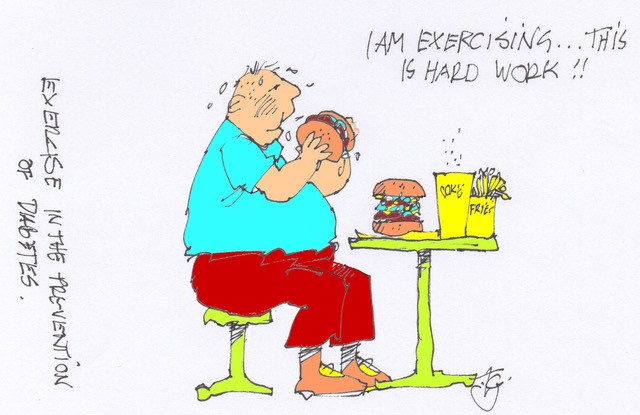EXERCISE AND DIABETES
Type 2 versus Type 1 diabetes mellitus
Type 2 diabetes mellitus (T2DM) is what we are talking about. Type 1 DM is something else although it is also a risk factor for cardiovascular disease. T1DM is a condition whose onset is usually in young people whose pancreas fairly suddenly packs in and stops producing insulin. Type 1 diabetics can only survive by regularly injecting themselves with insulin for the rest of their days.
T2DM develops later in life and is largely a result of an unhealthy lifestyle. There is a genetic element. The tendency to develop T2DM is inherited but it rarely manifests in the absence of over-eating and under-exercising. This form of diabetes is a growing epidemic with progressive increases in rates of diagnosis as the population becomes older and fatter – and less active. In the mid-nineteen nineties about two to three per cent of the UK population were known to be affected. The figure now is about 6% and growing. There are about four million diabetic patients in the UK, with more than 21,000 deaths per annum. The cost to the NHS of managing diabetes is a staggering £11.7 billion which is more than 12% of the total NHS budget!
Prevention is the key to reducing this epidemic – so it is extremely helpful to know the exercise and fitness levels of diabetics. This has now been examined in a group of 150 individuals with T2DM attending a single medical centre. All underwent a maximal treadmill exercise test1. The mean age was 54.9 and BMI (body mass index – see glossary) was 34.5 – well into the obese category. Average reported daily activity was expressed as kcal/kg and came to 34.3 kcal/kg which is only 7% above the sedentary state.
Fitness levels
These were very low – as measured by the rate of uptake of oxygen at peak exercise (VO2peak). VO2peak and VO2max are the most precise measures of physical fitness. I will devote a future Blog to explaining this measurement and how it can be assessed – and how you can measure it for yourself. In this case the mean VO2peak was 18.8 ml/kg/min.Suffice it to say, the average level for this age group should be about 32 for men and 27 for women. A level of 18.8 would be normal for an 80 year old man and a 70 year old woman.
In brief the members of this group were obese, took very little exercise and were extremely unfit. T2DM is a serious disease (there is no such thing as “mild” diabetes) and brings with it a panoply of ill effects. These include heart attacks, strokes, kidney disease, blindness, amputation, susceptibility to infection and premature mortality.
I wonder how many diabetics are aware of the complications of T2DM and the fact that these are largely preventable by their own efforts? Both the prevention and the treatment of T2DM require a combination of sensible diet and adequate exercise. What this study shows us is that the lack of exercise with subsequent unfitness is a major component of this unholy duo.
1. doi.org/10.2337/dc18-2634
Subscribe to the blog
Categories
- Accelerometer
- Alzheimer's disease
- Blood pressure
- BMI
- Cancer
- Complications
- Coronary disease
- Cycling
- Dementia
- Diabetes
- Events
- Evidence
- Exercise promotion
- Frailty
- Healthspan
- Hearty News
- Hypertension
- Ill effects
- Infections
- Lifespan
- Lipids
- Lung disease
- Mental health
- Mental health
- Muscles
- Obesity
- Osteoporosis
- Oxygen uptake
- Parkinson's Disease
- Physical activity
- Physical fitness
- Running
- Sedentary behaviour
- Strength training
- Stroke
- Uncategorized
- Walking



You do not state the gender of the group with type 2 diabetes. Was it representative of both men and women?
Thanks Thomas – and apologies for not including this information. The study comes from Colorado, US, – 41% were women, 40% were black and 21% were Hispanic. Clearly a different population to that seen in UK diabetic clinics but I suspect that the findings this side of the pond would not be much different. Hugh
The figures speak for themselves, quite remarkable. This message needs to be broadcast from the rooftops, it needs to be taught at schools, it needs to be a part of our daily diet of information.
You are right Mike.
Children are naturally active even before they are born.
Parent are increasingly worried about allowing children the freedom to run, climb tress and explore and the opportunities to do so may be too far or too difficult to access with public transport decreasing.
Parks are often taken over by attractions or activities with expensive fees. Woods and beaches make great playgrounds, if they are accessible.
Working parents catch up with chores at weekends and are also often fixed to their mobile phones.
Children learn by example and area also some schools find it difficult to fit in sports classes.
The holidays area used by some schools to provide play scheme to raise extra funds for their school.
Sports Centres and clubs counts and guides, bicycles, all need funds, making them inaccessible to some.
It is not all doom and gloom. We all (unless disables) have two legs and feet and can walk and walking is a good exercise in itself.
Although our children as teenagers were embarrassed by seeing us running when they were out with their friends, they all exercise, including running, and encourage their children to do so as well.
It is never too late to start, but it does need to become a good habit.
Exercise has such profound benefits for body and mind and once started, it becomes easier surprisingly quickly!